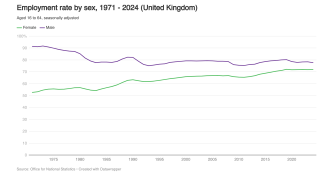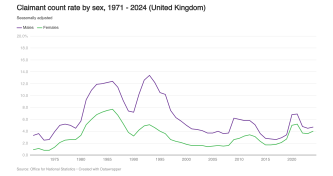Source: Office for National Statistics – Unemployment
Notes:
- The chart shows the unemployment rate for those aged 16 and over.
- The level and rate of UK unemployment is currently measured by the Labour Force Survey (LFS) using a definition of unemployment specified by the International Labour Organisation (ILO). Unemployed people are those without a job who have been actively seeking work in the past 4 weeks and are available to start work in the next 2 weeks. It also includes those who are out of work but have found a job and are waiting to start in the next 2 weeks.
- The LFS was carried out every two years until 1983. Between 1984 and 1991, data were collected annually. The survey has been running in its present form, with quarterly sampling, since spring 1992, with a change from seasonal to calendar quarters in 2006. The Office for National Statistics website provides additional information on the quality and methodology of the LFS.
| Key dates | |
|---|---|
| 1996 | Employment Rights Act Consolidated a wide range of employee rights related to issues such as unfair dismissal, parental leave and redundancy. |
| 1998 | Working Time Regulations Regulations which set a maximum of 48 hours for the working week on average. |
| 1998 | National Minimum Wage Act Defined a minimum hourly rate which employers must pay their workers. |
| 2000 | Part-Time Workers (Prevention of Less Favourable Treatment) Regulations Regulations protecting part-time workers from less favourable treatment than their full-time colleagues. |
| 2010 | Equality Act Prohibited discrimination based on protected characteristics such as age, disability, religion and gender. |
| 2016 | National Living Wage introduced A higher minimum wage rate for all workers over 25 years of age, and later expanded to 21 and over in 2024. |
| 2020 | COVID-19 pandemic January 2020 saw the first confirmed cases of COVID-19 in the UK. |
About CLOSER
This page is part of Our Changing Society, a free resource developed by CLOSER to provide detailed information about the historical and political backdrop to study participants’ lives.
CLOSER’s mission is to increase the visibility, use and impact of longitudinal population studies, data and research to ensure that longitudinal evidence is used to address the health, social, economic and environmental challenges facing the UK, now and in the future.
Want to know more?
- Longitudinal News – Sign up to our monthly newsletter to hear about the latest news, blogs, research and events from the longitudinal community.
- Learning Hub – Find information and resources to help you better understand longitudinal population studies and how to use the data.
- CLOSER Discovery – Search and explore data in the UK’s most detailed search engine for longitudinal population studies.



